
The recent vinyl reissue of Shiner’s mammoth Lula Divinia was a welcome marker of my twentieth year of listening to Allen Epley’s music. Whereas many other musicians in my circa-1997 heavy rotation have either lost my interest or lost their commitment, Epley has been a model of creative consistency with Shiner and The Life and Times. Lineups have shifted, aesthetics have evolved from Midwestern math-rock to sinewy shoegaze, yet the touchstones of Epley’s craft remain resolute: strong vocal melodies, often tinged with melancholy; slyly complex arrangements punctuated with immensely satisfying riffs; and a rhythm section with its own gravitational pull.
With their fifth, eponymous LP, The Life and Times has surpassed its primary predecessor in both duration and output. After switching rhythm sections for 2005’s debut LP Suburban Hymns, the trio of Epley, bassist Eric Abert (Ring, Cicada), and drummer Chris Metcalf (The Stella Link) has remained stable (aside from a brief dalliance with Traindodge’s Rob Smith) and has their approach locked down. Records lean in different directions—the shoegaze sonics of 2006’s The Magician EP, the cinematic scope of 2009’s Tragic Boogie, the brass-tacks immediacy of 2012’s No One Loves You Like I Do, the melodic surges of 2014’s Lost Bees—but each fits firmly within the group’s catalog as a whole. Both last year’s all-covers Doppelgänger EP (worth the download) and this self-titled LP operate in a middle ground of these leanings, assured of their stylistic parameters.
Reliability doesn’t make for a particularly sexy narrative—“Excellent Band Continues to Be Excellent”—but the songwriting on The Life and Times earns the group another long-term residence in the aforementioned heavy-rotation pile. Its bookends are the album’s longest and strongest tracks, each mining a familiar Epley lyrical motif: “Killing Queens” explores the thin line between adoration and obsession with falsetto verses and a roaring, slide-enabled chorus riff, while “We Know” sees midlife ennui haunted by creeping dread, as spaced-out chimes give way to Chris Metcalf’s pummeling outro. “Dear Linda” emerges from its shoegaze cocoon to find bracing clarity via the rhythm section. The colossal bridge riff of “Group Think” recalls Shiner’s finest moment, the ascendant mid-song interplay of “The Situationist.” “Out Thru the In Door” splits the difference between slippery post-punk verses and a sing-along chorus worthy of the Zeppelin smirk in its title. Abert leads the practically dance-ready “T=D/S,” his bass flipping between notes before opening up in the swirling chorus. The alternately dreamy and anthemic “I Am the Wedding Cake” undercuts its romantic overtures with a striking inclusion of “I don’t know you” in the chorus. Only the languid breather “Falling Awake” fails to leave much of an impression, but it does clear the deck for the pulsing instrumental “Dark Mavis.” Nine songs in a tight forty-one minutes, with each song inhabiting its logical residence in the running order.
It would honestly be easier if The Life and Times had a dramatic narrative, if Allen Epley became a hermit after The Egg and reappeared sixteen years later with a long-overdue reminder of what made his music compelling in the first place. But I’ll take the commitment to a regular release schedule and to the road, I’ll take the stack of worthy releases that have maintained my interest in that span. Whether The Life and Times sifts out as the finest in their catalog is up for debate—it’s certainly in the running—but the best thing about the group’s discography is that convincing cases can be made for virtually all of their albums.
|
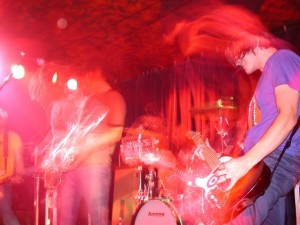
I first heard Shiner in 1997 via a mix tape containing “Fetch a Switch” and “The Situationist,” the best songs from their first two records, 1995’s Splay and the recently released Lula Divinia. I consulted Parasol Records’ catalog description to make sure my ears weren’t deceiving me—“Hum meets Jawbox,” yes, please—and promptly ordered Lula. Instantly a fan, I eagerly picked up their Sub Pop 7” for “Sleep It Off” b/w “Half Empty” and proudly wore a “SHINER” mock-Army t-shirt in high school. Absolutely none of my classmates understood it.
That changed when I left for college Champaign, IL, in 1999. The Midwest was Shiner’s literal stomping ground; they toured constantly and left ears ringing in their wake. Yet it’s still shocking to me that I’d get to see a non-local band eleven times in four years, even if it involved going to five other cities in the Midwest. Appropriately enough, only Allen Epley’s post-Shiner band The Life and Times matches that total.
That tie is about to be broken, however, since Shiner has reunited for five shows this summer in honor of an impending vinyl pressing of their 2001 swan song, The Egg. The concerts are slated for each member’s respective home city: New York, Chicago (x2), Kansas City, and Los Angeles, and you’re damn right I’m driving down to New York for my twelfth Shiner show.
In honor of this occasion, I’ve decided to do two things. First, if you haven’t heard Lula Divinia or The Egg, I’ll do you a favor and tell you to stop reading and buy them immediately. The combination of supreme heft, math-rock-inclined arrangements, and sneaky melodies is a gift that keeps giving. Second, I’m going to look back at each of the eleven previous times I saw Shiner. I’ll drag out photos, recall the accompanying acts (many of whom were legitimately great on their own accord), and do my best to remember the actual sets.
1/28/2000 at the Rocketbar in St. Louis, MO
I scored a ride from Champaign down to St. Louis because Centaur, Matt Talbott’s post-Hum band, was booked for its second-ever show there. I rolled with a lot of Hum fanatics at the time, and three of us had just seen Centaur play its first-ever show at a VFW in Danville, IL, a hangdog affair in which band members confused their then-numbered songs in front of some completely oblivious locals. This time, my friend Jackie and I were considerably more excited to see Shiner.
Autosleeper was first on the bill. The band name is presumably a reference to the Chapterhouse song title, but I remember thinking they were a pale imitation of both Shiner and Hum, not Midwestern-gaze.
Centaur’s sheepish emergence into the world continued. I have three distinct memories of their performance: Matt Talbott’s comically large beer bottle being at odds with their otherwise stoic stage presence; what would eventually become “The Same Place” comprising the best eight minutes of the set; and Talbott’s wah pedal breaking two songs in, to which he sighed “My band’s in this pedal.” Their performance sputtered out after one more song, proving Talbott’s assertion that his pedal truly was indispensible.
Shiner took the stage as a four-piece with Jason Gerken on drums and Josh Newton on second guitar, a new line-up for the group, not that I’d seen the others. Gerken had taken over for much-heralded Tim Dow, who’d moved to Los Angeles (where he’d collaborate with Failure’s Ken Andrews in both On and Year of the Rabbit). Newton replaced Joel Hamilton, who’d appeared on “Sailor’s Fate,” the solid b-side to their stellar 1999 single “Semper Fi.” True to Shiner form, both members had served time in Kansas City’s Season to Risk, but Gerken was more known for Molly McGuire, Newton better associated with Glazed Baby.
I was impressed by early versions of songs that would end up on Starless, especially “Unglued” and “Lazy Eye” (which sounded more eerie and threatening than it would on the album), but most of my memories from that night were of Gerken’s appearance and performance. He went shirtless with overalls—not a look I could pull off—and played with a swagger that he’d later tone down. I was borderline terrified of him.
9/28/2000 at the Metro in Chicago, IL
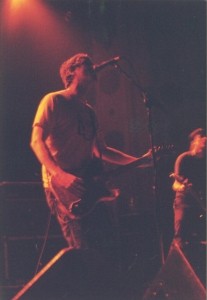
I celebrated the night before my 20th birthday with a trip up to Chicago for the dude-rockingest night of the Flower Booking Festival. In hindsight, I should have attended all of the nights: Trans Am, Don Caballero, Tortoise, The Sea & Cake, Grifters, Turing Machine, etc., but come on, Burning Airlines and Shiner? That’s the one I’m attending.
Bluetip started off the evening as no slouch of an opening act. I’d only heard the Hot (-) Fast (+) Union EP at the time, but I enjoyed it, especially “Compliment the Negative.” Did I immediately pick up the rest of their back catalog? Of course not. I regret this inaction. They were solid live and I never got to see them again.
Shiner was second on the bill, which meant they played a shorter set than I would have preferred. It was good hearing the Starless songs after the record came out—the title track was considerably better live. I recall “Fetch a Switch” making a welcome appearance.
The recently formed Hey Mercedes (75% of Braid) was third. I’d seen them in Champaign with Rectangle a few weeks earlier and learned a valuable lesson about the diminishing returns of early Hey Mercedes shows. The first song: “Whoa, this is great! It’s catchier than Braid!” Third song: “Still good! Still catchy!” Fifth song: Looks at watch. Seventh song: “How many more dunna-nuh, dunna-dunnas do they have in them?” In short, they didn’t have forty minutes of varied material yet and by the end of their set I was exhausted. I enjoyed their shows more once they had a full LP out, but as it turned out, “Bells” and “The House Shook” from that first EP remain my two favorite Hey Mercedes songs.
I’d seen Burning Airlines the previous October at the Highdive in Champaign, but this time they had a bunch of new material that was being road-tested before appearing on Identikit. Hearing “A Song With No Words” for the first time that evening was phenomenal. I wish I could watch J. Robbins play guitar every night, but sadly, he has other things to do.
I am fairly sure The Promise Ring were the evening’s special guest, but sticking around for another band after Burning Airlines felt sacrilegious to me. I did see The Promise Ring three other times in college, two of which were enjoyable sets highlighted by Davey Von Bohlen’s deft handling of hecklers, the last a baffling pre-Wood/Water set that trading their pop-punk enthusiasm for alt-country slogs.
1/20/2001 at the Highdive, Champaign, IL
Perhaps owing to the fact that I didn’t have to drive to a different city to attend the show, I can’t remember many of the details about this show. Centaur had certainly improved—their songs likely had names, not numbers by this point—and drummer Jim Kelly and bassist Derek Niedringhaus were holding down the fort. It was still a year before In Streams would come out. Will it ever get a follow-up? Who knows. They played unreleased songs at later shows, but even those concerts were way back in 2004 and 2005.
As for Shiner, I wish I had the set list for this show, since I’m curious whether they’d started to play songs from The Egg yet. My gut says no, but there are YouTube clips from a show at the Bottleneck in Kansas City from 2/3/2001 for “Surgery,” “The Simple Truth,” “Spook the Herd” (vastly different lyrics), “Bells and Whistles,” and “The Truth about Cows.” My guess is that they chose to debut the new material at the hometown show.
5/11/2001 at the Galaxy in St. Louis, MO
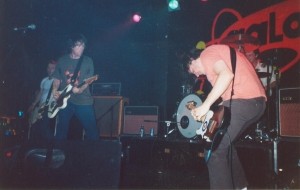
With the finals of my sophomore year of college in the rearview, my then-girlfriend, now-wife (henceforth TGNW) and I drove down to St. Louis to hang out with my friend Jon Mount and see Shiner for the fourth time. Given the fact that Riddle of Steel’s bassist ran the Rocketbar, I was surprised that the show wasn’t over there.
Both opening acts were bands that my peers generally appreciated more than I did. Riddle of Steel combined Midwestern indie rock with a larger dose of hard rock. If I lived in St. Louis, I likely would have seen them countless times, but they didn’t play Champaign much.
Houston had the Copper Press (the print magazine I occasionally contributed to, including a piece on Shiner) stamp of approval, since editor Steve Brydges snapped them up for his label, 54 40 or Fight, but I couldn’t get into them for one simple reason: their live guitar tone. It evoked a thinner, more metallic version of the guitar tones of Failure’s Comfort, which was like nails on a chalkboard for me. That’s a damn shame, since I otherwise liked their songwriting. (The cover art for Bottom of the Curve is inexcusably terrible, though.) I saw Houston three other times: their best performance came on a bill with Ring, Cicada at the Prairie House in Bloomington, IL.
One between-song comment to Jon Mount stands out about this show. After Shiner played “The Situationist” near the end of their set, I said “They definitely know which songs are their best,” to which he agreed. I’ve seen bands that play everything but the three or four best songs in their catalog, which is infuriating, but Allen Epley’s bands have never suffered from that issue.
8/11/2001 at the Southgate House in Newport, KY
If I had to rank my favorite all-time shows—a simple dare would get this project started—this one would be up there. I got to leave early from a family get-together for my TGNW’s family, which alone was cause for celebration, and cross from Cincinnati over to Newport, Kentucky for the show. The Southgate House was a great venue, like someone stuck a less claustrophobic version of the Middle East Downstairs into the back of a huge house. And the bill was, for my tastes, comparable to the Flower Booking night.
I was introduced to Spain’s Aina from a split 7” with The Capitol City Dusters in 1999. Aina’s contribution, “Lutton Can Wait,” is one of my most-played sides of vinyl, to the point where I had to buy a second copy of the record. Their sound is as easy to describe as it is to appreciate: the DC rock of Jawbox and Fugazi cut with the hard rock of AC/DC. Even with my fondness for “Lutton Can Wait,” I didn’t expect them to be this good. When a massive thunderstorm opened up outside midway through their set, singer/guitarist Artur Estrada pointed up at the lightning strikes and the band hit another gear. If you missed out on them, put their 1998 self-titled LP and 2001’s Bipartite on your to-buy list and check out Artur Estrada’s next band, Nueva Vulcano.
This is what I remember about Shiner’s set: “Holy shit, ‘The Egg’ and ‘The Simple Truth’ are insanely good.” The former might be Jason Gerken’s answer to Tim Dow’s work on “My Life as a Housewife,” whereas the latter pulled in some post-rock influence to excellent effect.
I could have gone home ecstatic after Aina and Shiner, but Burning Airlines was the icing on the cake. They played a solid, Identikit-heavy set. I remember talking to drummer Pete Moffett at the show, but damned if I recall what we chatted about. I got to see them one final time in Champaign the next month on another solid bill (Rival Schools and Hey Mercedes), but J. Robbins’ days of heavy touring were soon coming to a close. Am I still bummed Jawbox didn’t do any proper reunion shows for the For Your Own Special Sweetheart reissue? Yes, yes I am.
10/19/2001 at the Metro in Chicago, IL
In one of the weirder bills in my concert-going history, Shiner took the middle slot between two Barsuk bands, piano rockers The Prom and the rapidly ascending Death Cab for Cutie. In one sense, Shiner and Death Cab sharing a bill makes sense, since Death Cab toured with Shiner’s DeSoto Records label-mates The Dismemberment Plan and briefly shared bassist Nick Harmer with another beloved DeSoto band, Juno. But despite the mutual fondness for both bands between my TGNW and me, bridging the gap between air-drumming dude-rockers and a sensitive emo kids was a tall order.
There was no doubt which side of that ledger The Prom fell on. Imagine Ben Folds Five’s “Brick” as an early 2000s emo song and you’re 85% of the way there. Fortunately, my now-wife didn’t care for them, so I avoided having to buy that CD and hear it a few times. Phew.
My desire to hear songs from Shiner’s forthcoming The Egg again was bordering on a bodily need. It’s different now that you can see videos of unreleased songs on YouTube before they’re recorded, but in 2001, the only way I could wrap my head around “The Simple Truth” and “The Egg” was to see Shiner perform them as much as possible. It was a rare situation even then—most bands don’t tour heavily before their new album comes out, but Shiner was an exception to that rule. I’m endlessly thankful that they were.
The album was three days away from its release, but by this point “The Simple Truth” and “The Egg” were the standouts of their set. I reveled in the fact a number of Death Cab fans around me were plugging their fingers into their ears and grimacing.
I remember talking to Josh Newton at this show and asking him how their dates with Death Cab were going. He relayed a story from one of the previous nights, in which he was in the back of the club playing Golden Tee during their set, and the song approached silence. Naturally, Golden Tee made a ton of noise and a good percentage of the audience turned around and glared at him.
The members of Death Cab for Cutie, however, had a better sense of humor. Their amps had DC/FC stylized in the AC/DC font, so naturally I yelled out for AC/DC songs. They laughed, but sadly didn’t break out a rendition of “Big Balls.” I couldn’t help but feel the letdown after Shiner, however, since Death Cab’s set was quieter than the one they’d played at the sweaty Fireside Bowl nine months earlier (before The Photo Album increased their hype considerably) and couldn’t help but feel like an elongated, post-coital cuddle session.
One more note: we also managed to see Rectangle and Danger Adventure at The Big Horse, a Mexican restaurant/music venue. It was the only time I saw Rectangle outside of Urbana-Champaign, but the sound was so terrible that I probably only heard half of them.
10/20/2001 at the Highdive in Champaign, IL
There aren’t many bands I’ve seen on back-to-back nights, but Shiner joined the club when they headed down to Champaign to play The Egg in its entirety. That gimmick isn’t necessarily my favorite—I like guessing which song’s coming up next—but it worked for Shiner, since The Egg is an album in the way some decrepit Rolling Stone critic might someday elucidate. Plus they weren’t doing it as a way to milk dutiful fans out of another $40 (cough, Pixies, cough).
Not that I needed more reason to attend, but finally getting to see Collinsville, Illinois, instrumental rockers, Ring, Cicada as the lone openers for this show, but waiting is appropriate for the band. Having existed in some form or another since the mid ’90s, Ring, Cicada didn’t release a proper LP until 2003’s Good Morning, Mr. Good, which was sadly overlooked. They had a few short run EPs before the LP, but nothing that extended past regional affection. Naturally, all of my friends who had seen then raved about their performances, and rightly so: Ring, Cicada played an unusually emotional brand of math-rock. I remember being floored by their guitar tones, which were the direct opposite of Houston’s Achilles heel. I could throw a bunch of tired adjectives at you—warm, full-bodied, rich—but they wouldn’t tell the whole story. Guitarist Christian Powell emerged as an occasional vocalist on Good Morning, but the instrumental takes were hardly deficient.
Two key Shiner connections: first, bassist Eric Abert has been in The Life and Times since 2005, second, Ring, Cicada is on the bill for the Shiner reunion show at the Bottom Lounge, which makes me sad I’m no longer within driving range of Chicago.
4/6/2002 at the Highdive in Champaign, IL
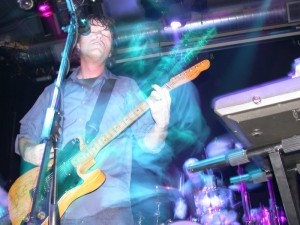
I’d come back from a road trip to Louisville, Kentucky the day before, glowing from a dominating triple bill of Fugazi, Shipping News, and Rachel’s (RIP Jason Noble), and was thrilled to see Shiner as well. While the Flower Booking and Southgate House bills were better, this evening might rank as my favorite Shiner performance.
The only opener was Schatzi, who bridged the gap between indie rock, emo, and pop-punk. Super enthusiastic and melodically driven, like a cross between Superchunk and The Get-Up Kids. I thought of them last year when I heard Hammer No More the Fingers’ Black Shark; it’s similarly catchy, but HMNTF's songs stuck with me, whereas I forgot about Schatzi’s songs by the end of the night.
Feel free to blame Shiner’s set for my Schatzi amnesia. They played both of the Japanese bonus tracks from The Egg, “Dirty Jazz” and “I’ll Leave Without You,” which were great live. They continued to play the best songs from The Egg, along with the highlights from earlier records. Perhaps the most obvious reason for me to think of this show more than the others is that I have a 24x18” blow-up of the accompanying photo above my desk.
I took it with my new Nikon digital camera, which I was still learning how to use. Results were mixed, but since Shiner didn’t shy away from lights, I could do my flash-and-long-exposure technique to get either motion or ghost images. That particular photo is the best ghost image I’ve ever taken—Epley looks like he’s conjuring a raging spirit. If I had steadier hands, maybe Gerken’s kit wouldn’t look like a neon smear.
7/3/2002 at Radio Radio in Indianapolis, IN
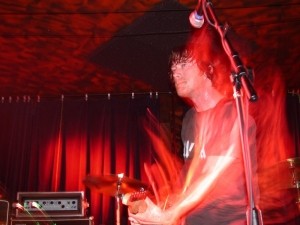
I’ve mentioned my TGNW a few times, but I have to give her credit: When I’d have the crazy idea to drive out to Indianapolis to see Shiner the night before the Fourth of July, she gladly tagged along. And this show was in the pre-Yelp days, so I literally knew nothing else to do in Indianapolis. If it wasn’t on the block of the club, I didn’t know about it. I guarantee we ate dinner at some shitty pizza joint. That was the golden age for shitty pizza joints.
New York City’s Pilot to Gunner was the first act on the bill. I’d heard their Hit the Ground and Hum EP when it came out, since its press release named the right names (Jawbox, Mission of Burma), but wasn’t impressed. The day of the show I decided to check out their new full length, Games at High Speed, on eMusic, and was stunned by how much they’d improved. Their high-energy post-punk shout-alongs were even better live. I chatted with them after their set and learned they’d just played the Prairie House in Bloomington, IL, and one of them sheepishly admitted to making out with Nudie, a frequent visitor to the Prairie House. Nudie, as you might imagine, had a tendency to get naked (along with one of house’s residents) in the routine after-show dance parties. More importantly, Nudie had a tattoo on her inner thigh: an arrow pointing crotchward with “Tasty” written nearby. Regardless of their beer goggles, I still enjoy Pilot to Gunner a great deal, and am glad they’re finally following up 2004’s Get Saved with the upcoming Guilty Guilty on Arctic Rodeo Records (the same label that’s issuing Burning Airlines’ two albums on vinyl).
Shiner’s set was looser than the past few—they weren’t promoting The Egg as hard and they were in the middle slot on the bill, so they skipped around their albums a bit more. As much as I loved hearing songs from The Egg the previous summer, it was nice to get more from Lula again.
Jets to Brazil closed out the show. Is it slander to admit that I was never obsessed with Jawbreaker or Jets to Brazil? Probably just lost a bunch of cred points. I do enjoy Orange Rhyming Dictionary, especially “Chinatown” (along with a few Jawbreaker albums), but when it came down to Jawbox/Burning Airlines vs. Jawbreaker/Jets to Brazil in the non-existent battle of the similarly named bands, I’m a J. Robbins guy all the way.
11/11/2002 at The Highdive in Champaign, IL
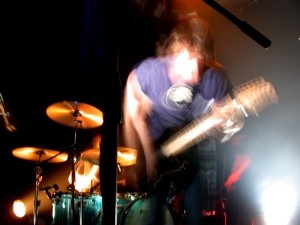
I doubt that I saw any of The Capitol City Dusters’ set and here’s why: I had a long interview with Aina drummer Pau Santesmasses, who had the best command of English in the group, and planned to work it into a piece for Copper Press. But I assume that my finals kept me from working on it, and the interview—which I remember being quite insightful to their fondness for DC music—sat on a microcassette, untouched. It’s probably still in a bin in my basement. I feel genuinely shitty about it.
Aina, of course, were excellent, just like they’d been the year before. By this point I’d been able to process their records, so the shock and awe of the Southgate House performance had worn off, but their command of the material hadn't. I gladly would have seen them another nine times, but they broke up after a pair of EPs.
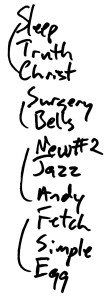
I only have one Shiner set list in my possession and it’s from this show. Do I remember what “New #2” was? Sadly not. Otherwise, the song selection is flawless. “Sleep It Off” from the Sub Pop single has always been one of my favorites, and I don’t recall them playing it too often.
One note: I believe this was the show when Paul Malinowski said something like “I see you at a lot of these shows” to me. Yes, yes you did.
1/25/2003 at the Madrid Theater in Kansas City, MO
When Shiner announced in late 2002 that they were breaking up, I wasn’t hugely surprised. That may be strange for an obsessive fan to admit, but what drove Shiner was Allen Epley’s desire to improve the band. That’s what he did with the three-piece version on Lula Divinia vs. Splay, that’s what he did with the four-piece version on The Egg vs. Starless. In some ways, Shiner wrote themselves into a corner with The Egg; there was no inferior band member to replace, no obvious flaw to correct. The clearest course was to do something different, which was easier to do with a new band name and new collaborators. Epley’s too committed to music to quit entirely, so I knew he wasn’t going to disappear into a day job, and sure enough, he emerged a shortly after with The Life and Times.
That isn’t to say that I wasn’t disappointed that Shiner was breaking up, since I wouldn’t get to see those songs live again (for a decade, at least). As such, there was no way in hell I’d miss out on their final show. It’s the longest I’ve driven for a concert—although I admittedly flew from Boston to Seattle for Juno’s reunion shows—and I’m eternally grateful that Jackie, Jon, and Bill joined me for the adventure. It’s entirely possible I might have died on the drive back to St. Louis if not for the gentle nudge that I should stop and walk around.
I remember very little about opening act Elevator Division—they were the local opener without the local sound, and given the number of Kansas City bands I’ve enjoyed over the years, that felt like an intrusion on a proper send-off. In comparison, Shiner’s common touring partner Houston was a good fit, irritating guitar tone be damned.
The last opening act was considerably more exciting. Dirtnap was/is a Kansas City band who’d released two excellent records (the still-weird combination of atmospheric Slint post-rock and aggressive Midwestern rock of 1997’s Below the Speed of Sound and the emotional resonance and superlative guitar work of 2003’s Long Songs for Short Term Friends), but hadn’t ventured out to Champaign during my time there. They apparently played a show in Kansas City back in April, which fortunately made it up to YouTube. Excuse me while I watch all of it.
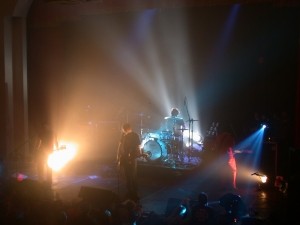
Shiner’s final performance was a blowout in the best possible way. They played 24 songs in a nearly two-hour-long set. Thax Douglas, poet laureate of rock shows in Chicago, came out to do a reading. They played songs I hadn’t heard them do in ages (“Released,” “Sideways”/“Pinned”). The encore started with the Splay lineup of Epley, Dow, and bassist Shawn Sherrill performing “Brooks,” then swapped Sherrill for Malinowski to do Lula material, including Dow’s drumming clinic “My Life as a Housewife.” (Fun fact: Gerken wouldn’t do “Housewife” because Dow owned it so much.) Watching Dow drum was a thrill—he’s a much smaller guy than Gerken, but still hits with such power and precision. Newton and Gerken reemerged for the last few songs, closing the night with “Starless.” It was an appropriately somber closing note, reminding everybody that yes, they’re done.
(Until the reunion shows, of course.)
You can download their final set here. Thanks to whoever originally recorded and dispersed it. I believe Shiner is still planning on releasing a retrospective DVD, which may contain some or all of this set.
|
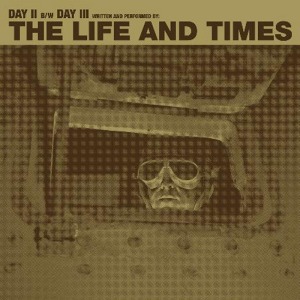
Has it really been twelve years since Allen Epley of The Life and Times / Shiner released new music on seven-inch vinyl? 1999 is when the superb “Semper Fi” b/w “A Sailor’s Fate” came out on DeSoto, part of a banner year for the label which also included Juno’s This Is the Way It Goes & Goes & Goes, Burning Airlines’ Mission: Control!, the Dismemberment Plan’s Emergency & I, and Faraquet’s “The Whole Thing Over” b/w “Call It Sane.” (Kim Coletta got a lot of my money that year.) I understand the drastic dip in interest in seven-inch singles during that span, but as I’ve noted before, Shiner excelled in the format. What I wouldn’t give for a seven-inch of the Japanese bonus tracks from The Egg (“Dirty Jazz” and “I’ll Leave Without You”) or the group’s cover of My Bloody Valentine’s “Only Shallow.” Seriously, I’ll probably dream about finding these items tonight.
With The Life and Times’ home studio all geared-out, it makes sense that Epley returns to trickling out a few new songs as they’re ready. Sometime later this year, The Life and Times will follow up 2009’s Tragic Boogie with their third full-length, but in the interim, they’ve issued “Day II” b/w “Day III” through Hawthorne Street Records (who’ve pressed vinyl editions of Suburban Hymns, The Magician, and Tragic Boogie). It marks the debut of the four-piece version of the group, having added Robert Culpepper Smith of Traindodge, Riddle of Steel, and Roma79 as on marimba (and keyboards, if these songs are any indication).
So how do “Day II” and “Day III” stack up with The Life and Times’ previous releases? Quite well: this single is a welcome, recommended return to (seven-inch) form. The former is an atmospheric rocker with Epley repeating “Nothing fools me” as the song shifts from a bass-heavy groove into a racing, riff-driven chorus. The latter calms things down considerably, pairing strummed acoustic guitars with woozy synth lines. The lyrics are intriguingly vague—“They said that mistakes were made / The very same mistakes we made / And history will eat itself”—fitting the song’s disorienting feel. Both of these songs rely on texture, but the strong riff of “Day II” and the lyrics of “Day III” provide stable footing.
Will these songs make the upcoming full-length? My guess is no. They stand alone nicely, perhaps acting as a bridge from Tragic Boogie to The Life and Times’ next album like Shiner’s “Sleep It Off” b/w “Half Empty” did between Lula Divinia and Starless. With any luck, The Life and Times has “Day IV” and “Day V” in the can, ready to hit colored wax in the fall after the LP’s out.
|
|
It’s clear from my nearly non-existent concert photography feed that I’ve cut down greatly on the number of shows I see each year, but it’s hard for me to pass up seeing one of Allen Epley’s bands. Between Shiner (eleven times) and The Life and Times (eight times), I’ve seen Epley nineteen total times in eight different cities (St. Louis, Chicago, Champaign, Indianapolis, Newport, KY, Kansas City, New York, Boston). The biggest difference between this concert and their opening slot for the Hum reunion show in January was my familiarity with their new album, Tragic Boogie, and the highlights of that record sounded great. Still no “Mea Culpa” or “A Chorus of Crickets,” but they’ve got to plug the new wares, which I discuss at length below. Short take: behind Lula Divinia, The Egg, and Suburban Hymns, but still worth checking out.
I was running late the night of this concert and missed Constants, whose excellent “Passage” was leaking out onto Harvard Ave. as I entered Great Scott. Unfortunately, it was the last song of their set. I was looking forward to hearing some material from their upcoming album The Foundation, The Machine, The Ascension, but I’ll have to wait for the 3LP release on Mylene Sheath, which ships in late June. Six feet of artwork and two choices of vinyl color for pre-orders, so get in line.
I did get to hear the excellent Deleted Scenes for the first time, and damned if they didn’t put on a great show. Hard to pin them down to a single sub-genre, but the Dismemberment Plan, Talking Heads, indie pop, and even some math-rock came up during the set, never as a singular influence. Singer Dan Scheuerman has a captivating stage presence and their songs are even better live. I wouldn’t be surprised if their next record pushes them into headlining slots across the country, but I grabbed their debut full-length, Birdseed Shirt, and talked to Scheuerman after the show.
63. Deleted Scenes – Birdseed Shirt CD – What Delicate, 2009 – $8
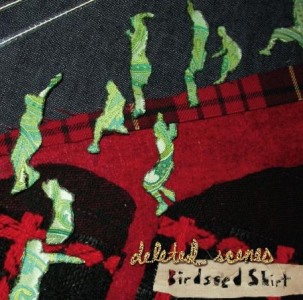
Deleted Scenes put on such a convincing performance that I had no choice but to pick up their debut full-length, Birdseed Shirt, on the loathed compact disc format. (It does not look like an LP is in the works, but my purchase of an album on CD almost assures it an eventual vinyl pressing.) Does Birdseed Shirt measure up to their live set? No, but it’s still a compelling album. There’s a considerable amount of production depth on these songs, but I’d argue that a few of the tricks (keeping vocals on one channel, for example), detract from the power of the songwriting. I keep meaning to give this album a few front-to-back spins, but I usually get stuck on highlights like the abrasive “Mortal Sin,” the gliding, melodic “Ithaca,” and the dourly triumphant “Turn to Sand.” They’ll be at TT the Bear’s on July 3rd, and I might just have to use that concert as an excuse to leave the house. Those live YouTubes are whetting my appetite.
64. The Life and Times – Tragic Boogie LP – Hawthorne Street, 2009 – $10
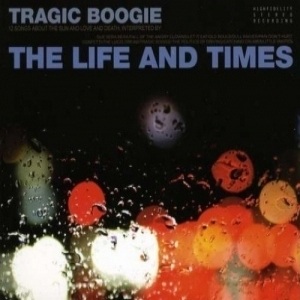
My fondness for Allen Epley’s massive, math-rock-influenced rock can admittedly affect my ability to assess his groups’ albums immediately after release, so excuse this long build-up to the discussion of Tragic Boogie. I remember claiming that Shiner’s Starless (2000) was an improvement upon Lula Divinia (1997) in a Signal Drench review, an opinion motivated by the initial surge of new music from one of my favorite groups and the desire to cement Shiner as one of the groups the magazine got behind, especially in light of a vicious Pitchfork review (which is now gone from the site). In hindsight, Starless was an occasionally awkward transitional record, suffering from too much deference from Epley’s guitar and Paul Malinowski’s bass to the second guitar being added by Joel Hamilton and Josh Newton. Whereas Lula Divinia felt mammoth with just three members, Starless feels strangely thin at points with four. The album felt less challenging than Lula as well, with both Epley’s songwriting and new drummer Jason Gerkin taking a more straightforward approach. I know there was a version floating around—either demos or an early studio cut—with Tim Dow still in the group, but I’ve never come close to hearing it, so it may very well be an urban legend. I doubt a change in drummers would have made “Too Much of Not Enough” a better song, however.
Starless took a full three years after Lula to come out, in part due to label changes. The record was originally slated for the New York label Zero Hour, who’d put out Swervedriver’s 99th Dream and a few other semi-notable records, but they folded and left Shiner in the lurch. Was there major label interest in the group during this time as well? Who knows, but I suspect Epley, a music lifer, would not have minded some financial security. Starless ended up being released on Owned & Operated, run by Descendents/All drummer Bill Stevenson, but they didn’t feel a part of O&O like they did on DeSoto. It felt like a stopgap solution, much like Starless now feels like a stopgap record.
Thankfully their follow-up record, 2001’s The Egg rectified all of these concerns. Back on DeSoto Records, Shiner seemed dead set on pushing themselves to the fullest on The Egg, making a nastier (“Surgery”), more technically challenging (“The Egg”), more inspired album (“The Simple Truth”) than Starless. Jason Gerkin’s syncopated drumming on the title track seemed like a direct response to any fans who longed for Tim Dow’s deft work on “My Life as a Housewife.” I’d seen the group enough times leading up to the CD’s release to know that those songs would hold up. Eight years later, The Egg is essentially a 1B option to Lula Divinia’s 1A, since the latter feels a little more natural, less forced. The set list for their final show backs me up. Three songs from Splay, five songs for Starless, seven from The Egg (including Japanese bonus track “Dirty Jazz”), and seven from Lula Divinia (eight if you include “Sleep It Off”). Maybe the presence of original drummer Tim Dow at the show encouraged more Lula songs, but I trust Epley’s ability to assess the strength of his own material in the live setting.
Shiner’s farewell concert was a bittersweet send-off, but I never questioned why they broke up—The Egg pushed that group as far, as hard as it would go and there was no logical follow-up. Bringing in new collaborators and starting again made sense; so much sense Epley did it twice with The Life and Times. The John Meredith / Mike Myers line-up only lasted for The Flat End of the Earth EP, but the Eric Abert / Chris Metcalf line-up has now released two full-lengths and two EPs on four different labels. I discussed Suburban Hymns and The Magician when I picked them up on vinyl back in January, but it’s been three long years since the latter came out, stretched out by an extended label search. Sound like a familiar situation?
According to the painstaking liner notes, Tragic Boogie was initially conceived in April 2007 after a tour with the Appleseed Cast. That group’s Low Level Owl albums must’ve inspired the Life and Times’ home-recording impulse, since without a label footing the bill, only a home studio would allow Epley and company enough time to equal the Appleseed Cast’s experimentation-laden three weeks in the studio for that double-disc affair. After building a home studio and convening for several big sessions, they’d finished mastering the record in April of 2008. It took a year of label-searching before the record was released on the New York-based Arena Rock Recording Company. I’d like to think that two months is enough time to let Tragic Boogie sink in, so here goes.
Tragic Boogie is undoubtedly a home-recorded album, but not for the reason you might expect. No, it doesn’t sound thin in comparison to Suburban Hymns (recorded primarily at Matt Talbott’s Great Western Record Recorders by J. Robbins and Paul Malinowski) or The Magician (recorded at the Magpie Cage by J. Robbins). In fact, it sounds remarkably full, filled with bells and whistles like textural guitar overdubs, vintage keyboards, swirling background vocals. Epley states that they were aiming to make “the larger-than-life record we’d been hearing in our heads” and there’s no doubt that they succeeded in that aim. Tragic Boogie passes on the traditional rock template used for Suburban Hymns songs like “Running Red Lights,” “Coat of Arms,” and “Charlotte St” in favor of the explorative shoegaze approach of “Thrill Ride” and “My Last Hostage.” But how it comes through as a home-recorded album (much like compatriots National Skyline’s Bliss & Death) is in the dominance of this aesthetic shift over the base songwriting on a number of songs. Give a band enough time to tinker with guitar textures, drum sounds, and additional instrumentation, and there’s a definite risk that those elements will define the record. It’s far less likely that a home studio will cause a group to reevaluate their songwriting practices, Unwound’s Leaves Turn Inside You being a rare example.
The relatively positive Pitchfork review of Tragic Boogie states that the first half of the album trumps a weaker second half on the merit of this massive, shoegaze-influenced aesthetic, but I’ll argue the opposite. The stretch of “The Lucid Dream,” “Tragic Boogie,” and “The Politics of Driving” is as strong as anything The Life and Times has done, since the meta-level storytelling feeds off of those echoing layers of guitar. “The Lucid Dream” is a woozy, My Bloody Valentine-esque (I don’t use the comparison lightly; they’ve earned it here) fever dream, drifting with violence, regret, and oblique perspectives on Epley’s continuing musical pursuits. The title track pulls things back into the light, connecting images of doomed astronauts to both the suburban lifestyle and the group’s ongoing difficulties in finding a label and a larger audience (“We’re floating in space in search of a home, with no radio”). The two-chord signal, the rubbery, expressive bass line, and the forceful drum fills propel this story onward. “The Politics of Driving” is the album’s highlight, giving enough space to the blend of Epley’s delay-heavy rhythm guitar, Metcalf’s keyboards, and Abert’s baritone guitar leads before kicking into gear with an ascendant, cathartic rush. The song sheds some insight into Epley’s desire to keep going in the face of those label difficulties, those personal changes, with lines like “But victory would fade / The winners felt their days had no meaning / And so they’d kneel and pray / For something new to chase / Into the deep blue sea” and “But we love them even more when they don’t return” recognizing the uncontrollable impulse to press forward, even if it means certain doom. Epley’s never shied away from meta-level songwriting—“The Situationist” has “I loved the time when a little clumsy rhyming could put the crown on your head,” “The Egg” is clearly about nurturing Shiner and pushing it forward, even as things break down—and these songs add to that ongoing, cross-band commentary.
Perhaps it’s my preference for Epley’s meta-commentary on his bands or his dark character studies (Shiner’s “Sleep It Off,” The Life and Times’ “Muscle Cars”), but my issue with the first half of the record is that a few of the songs seem content with vague imagistic lyrics without much meat to them. The first three songs are strong enough; “Que Sera Sera” works well as an equally triumphant and foreboding lead-off track; “The Fall of Angry Clowns” hits a rewarding chorus of “Strange feeling, growing older”; “Let It Eat” charges forward with aquatic vocals, “Regretting all the lost days… in a future world,” establishing a thematic consistency. But “Old Souls” wastes a nice vocal performance of “You wait for me and I will pick you up right here” with too many vocal effects on the other lines, “Dull Knives” loves/hates love with trite lines like “Push and shove, they fuck the pain away / They kiss the hurt away,” and “Confetti” is more memorable for its (admittedly awesome) descending guitar lead and acoustic outro than any of the lyrics. Add two solid instrumentals (“The Pain Don’t Hurt” and the album-closing “Li’l 4 Notes”) and a reasonably good song dating back to 2003 (“Catching Crumbs”) and I’m left wanting more to chew on. The three bonus tracks from the Japanese release—two remixes and the instrumental “Life Is Pleasure”—aren’t any help.
I’ve listened to Tragic Boogie a number of times and I’m still hearing new sonic touches, new overdubs, new vocal harmonies, so if you’re more interested in how the record sounds, it trumps anything else The Life and Times has released. Yet only half of the record has stayed with me from a lyrical perspective. I half-expected this change in musical priorities after the aesthetic-first approach for some of The Magician, but a large part of what appeals to me about Allen Epley’s music is how Shiner’s mammoth riffs and The Life and Times’ layered compositions interact with the lyrics. Epley’s three best records—Lula Divinia, The Egg, and Suburban Hymns—rely on this combination. Tragic Boogie, however, is only 75% there. I still rank it well above Starless, but it does remind me of the eventual disappointment over that record. Maybe I’m being too hard on one of my favorite musicians, but I personally hope The Life and Times will re-enter their home studio less enamored with the tricks of the trade and more comfortable thanks to a stabilized label situation, and with the critical insight of an external producer like Robbins or Malinowki, produce another album that ranks among Epley’s finest, not slightly below them. The aesthetic blueprint drafted here is ready and waiting.
|
|
I’d visited Everyday Music during my last trip to Seattle, although it’s moved locations since that visit. Last time I got Chavez’s Ride the Fader LP, Hot Snakes’ Audit in Progress LP, and at least one more album if memory serves. This time around I found my two LP purchases (and the vast majority of things I considered purchasing but passed on buying ) in the just-in bin, which was organized by day (!). The general rock LP stock felt somewhat picked-over, perhaps because of the prime location by the Jimi Hendrix statue, but the seven-inches had some fine stragglers from the glory days of 1990s indie rock.
34. Cocteau Twins – Lullabies LP – 4AD, 1982 – $6
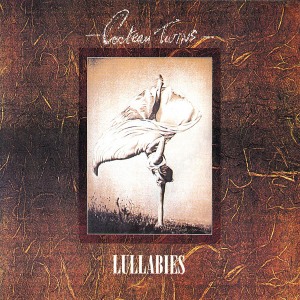
After seeing an LP copy of Blue Bell Knoll for $20 at Sonic Boom, I was a bit concerned that any Cocteau Twins material I’d find in town would be grossly overpriced, but six bucks for this EP seems entirely reasonable. I couldn’t remember if the songs on Lullabies were included on The Pink Opaque, their early singles compilation, but I checked their Wikipedia and found out that they’re not. I’ve passed on a few of the EPs because of that reason—as much as I love “The Spangle Maker,” I don’t need it on multiple LPs—but I I’m glad to have more of their early work. I still need to track down Garlands, which I found at Looney Tunes in Cambridge, but it turned out to be sleeve-only, since the LP inside was a different Cocteau Twins release. Maybe I’ll even find a copy of Heaven or Las Vegas one of these days.
As for Lullabies, it’s more aggressive than I anticipated, perhaps because of original bassist Will Heggie. “Feathered Oar Blades” is downright driving, with a nearly cacophonous drum conclusion, “Alas Dies Laughing” is woozy concoction of edgy guitar leads and Liz Fraser’s repetitive phrases, and “All but an Ark Lark” pushes forward for eight minutes before finishing off with Fraser’s whoops and Robin Guthrie’s guitar feedback.
35. Modest Mouse / 764-Hero – Whenever You See Fit LP – Up / Suicide Squeeze, 1998 – $8
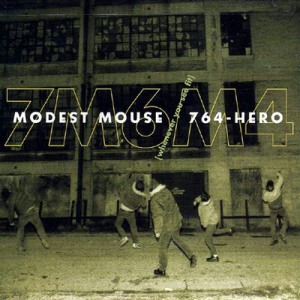
Modest Mouse vinyl goes for gross amounts on eBay, especially the double LP, double sleeve edition of Lonesome Crowded West (I recently saw an auction for just one of these LPs), but I’m not sure of the value of this release, especially since the store had two copies of it for eight bucks apiece. I grabbed Everywhere and His Nasty Parlour Tricks from Mystery Train last summer with the intent of selling it, but it’s becoming quite apparent that I’m not particularly apt at the money-making aspects of collecting records, unless I have absolutely no interest in the group.
That isn’t the case here, since I am fond of early Modest Mouse. I don’t, however, recall having heard this collaborative release between them and the forgettable 764-Hero. I saw 764-Hero and a pre-Oh Inverted World version of The Shins open) for Modest Mouse at the Highdive in Champaign and heard at least one of their records, but my only impression of the group was generic Northwestern indie rock, like some extrapolation of Built to Spill and Modest Mouse’s aesthetic without the charisma. Maybe time has been kinder to 764-Hero than I imagine, but I have a feeling this will be the only release of theirs I pick up. Having now listened to the song (not the two remixes, I’ll save those for a rainy day), it’s an endearingly shambling combination of both bands, with Isaac Brock’s vocals and guitar trumping most other elements in the song. I am disappointed that these two groups could only string “Whenever You See Fit” along for fourteen and a half minutes.
36. Shiner – “Sleep It Off” b/w “Half Empty” 7” – Sub Pop, 1997 – $1
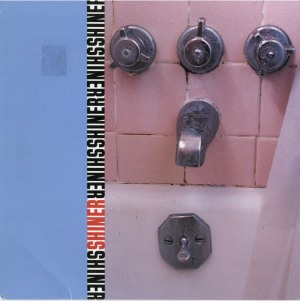
For a group that only pressed one of their full-lengths (their debut Splay) on vinyl, Shiner managed to put out a number of great singles, especially their Sub Pop single for “Sleep It Off” and “Half Empty.” The former made the re-release of Lula Divinia along with “Two Black Eyes” (which was originally included on a Law of Inertia compilation that also featured an early version of Durian’s “Four Mile Drop”), but “Half Empty” is just as good. “Brooks” b/w “Released” isn’t as essential, since both songs were on Splay, but “Cowboy” b/w “Floodwater” is worth hearing if you enjoy Splay-era Shiner. The split singles with Molly McGuire (“Crush”) and The Farewell Bend (“Spinning”) aren’t essential, but the former is exclusive and the latter is a slightly different version from the one on Starless. Ditto for “Semper Fi,” the best song from that album, but “A Sailor’s Fate” is a woozy, somewhat Louisville-influenced take on that era of Shiner’s sound. I tend to think of Shiner foremost as a live band, then an album band, but there’s good material on these singles and it’s a shame that some of them can be hard to track down.
A potential Shiner singles and rarities compilation could also include “Dirty Jazz” and “I’ll Leave Without You” from the Japanese pressing of The Egg, their cover of “Only Shallow” from the Grand Theft Autumn compilation, and a few unreleased tracks. It would provide fitting closure for Shiner, especially if they paired it with a DVD of their final performance in Kansas City. Considering that the group is working on a DVD release at the moment, this suggestion doesn’t seem to be unrealistic.
It shouldn’t be any surprise that I already owned this single, having ordered it from Parasol when it came out, but buying a second copy of a buck seemed like a no-brainer. I passed on a second copy of the Molly McGuire split single since I’m not exactly wearing out Shiner’s “Crush.”
37. Vitreous Humor – “My Midget” b/w “New Victoria Theater” 7” – Mute, 1996 – $2
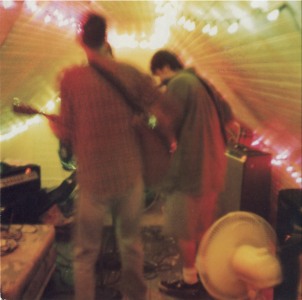
I have Vitreous Humor’s first single, but I can’t remember much about it beyond a vague recollection of that Crank!-style of Midwestern indie/emo. I had no idea that they’d signed to a major until I saw this single, but apparently their time on Mute was limited to this slice of wax. Neither of these songs sounds remotely like a cash-grab and “My Midget” even begins with some lengthy instrumental interplay. Time to check out their self-titled EP and aptly titled Posthumous CD.
After Vitreous Humor broke up, three of the members reconvened in the short-lived The Regrets, whose lone CD, New Directions: Result Beat Boasts, was pulled out of the Reckless dollar bin a few years ago. I have even less recollection of that CD except that it was somewhat poppier than the Vitreous Humor single. A year after the Regrets split, one-hit wonders Nada Surf covered Vitreous Humor’s “Why Are You So Mean to Me?” at the behest of their label, which even slotted it as the lead single for their second album. Please cover this obscure indie rock band’s song. We know it’ll be a hit. It sounds like they hired me as an A&R guy.
38. Wider – “Main” b/w “Strapping ½” 7” – Third Gear, 1995 – $0.50

I’d seen Wider cross-referenced a number of times in relation to Chavez, since James Lo played drums and Matt Sweeney played bass in this group prior to joining Chavez (although the latter doesn’t appear on this single). I’d never actually heard Wider, though, and it’s entirely possible that I’d never seen one of their singles before, either. There’s another 7” floating around for “Triangle” b/w “Bloom,” which seems to come up exclusively through eBay searches. Is there a full-length floating around as well? Wider isn’t the most Google-friendly band name.
The music, to my expectations, is typical early-to-mid 1990s aggressive math-rock, with vocals only on the A side. Buying this single right after Don Caballero’s For Respect makes a lot of sense to me.
|
|
To prove that I’m documenting every physical piece of music acquired in 2009, here’s what I bought at the Hum / Life and Times / Dianogah show.
1. The Life and Times – Suburban Hymns LP – Hawthorne Street, 2007 – $12 new
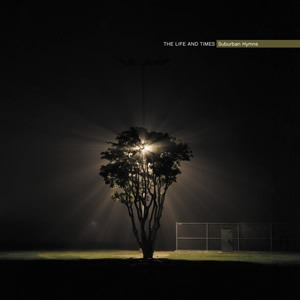
I can understand how some Shiner fans might have lost interest with the second incarnation of The Life and Times during the group’s transition to a shoegaze/math-rock hybrid, but Suburban Hymns is my third-favorite Epley album behind Lula Divinia and The Egg. I enjoyed The Flat End of the Earth EP, especially “Raisin in the Sun,” but I can’t fathom Epley releasing album after album of relatively dry, restrained indie rock. “Houdini” is essentially a shoegaze song stripped of its aesthetic, so the progression to the shoegaze-inflected Suburban Hymns made sense.
With the exception of the overly similar “Running Red Lights” and “Charlotte Street,” the variation from song to song keeps Suburban Hymns fresh. “Coat of Arms” revives War-era U2 drum fills, “Mea Culpa” is a pulsing, dynamic rocker reminiscent of Shiner’s epic “The Simple Truth,” “Muscle Cars” is a chiming, melancholic lament, “Skateland” lurks with seething menace, and “A Chorus of Crickets” somehow makes the apocalypse a rousing event. While there are moments of levity, like the rare Epley love song “Shift Your Gaze,” I tend to be drawn to the songs lingering between resigned pessimism and detached malaise, just like Shiner’s best single, “Sleep It Off” b/w “Half-Empty.”
If you haven’t picked the album up, Hawthorne Street’s clear vinyl pressing is a fine option. (The Magician is pressed on translucent yellow vinyl.) It would have been nice to have a gatefold sleeve with more artwork like the point-on cover, but considering that only one Shiner album (Splay) was pressed on LP, I won’t complain about the lack of frills. Not every group can be Pelican, after all.
2. The Life and Times – The Magician LP – Hawthorne Street, 2008 – $10

Unlike Suburban Hymns, The Magician takes a full step toward shoegaze, particularly on the first two tracks, “I Know You Are” and “Hush.” There’s too much low end to lump them in with most “nu-gaze” groups—Jon always complains about how Loveless needed a proper drum recording—but Epley’s effects-laden vocals and drifting guitar lines are a long way from Shiner’s “Brooks” and “Released.”
While I enjoy those shoegaze tracks and the up-tempo “Ave Maria,” “The Sound of the Ground” stands above the other songs on this EP. The melodies are clearer and more memorable than those on the other songs (“Ave Maria” is closest). The primary guitar line, drenched in delay, is completely absorbing. Just as important, you can actually understand Allen Epley’s vocals. My biggest issue with the shoegaze version of The Life and Times is how it detracts from Epley’s lyrics, since Shiner songs like “Fetch a Switch,” “The Situationist,” “Cake,” and “The Egg” are so compelling because of the combination of the lyrics and those mammoth, churning riffs. I can live without the weight of those riffs—begrudgingly—since there’s something filling the void, but placeholder lyrics are a disappointment.
It’s funny that my first two purchases of the new year are double dips—I own CD copies of both of these releases—since that’s something I’ve been trying to avoid doing. In this case, I try to support The Life and Times whenever possible, and I hadn’t seen them since the vinyl had been pressed.
|
|
Ever since I missed the majority of an epic Penguins–Flyers playoff OT tilt (the 5/4/2000 5OT classic) because of a National Skyline show and, more brutally, the Illinois comeback against Arizona in the 2005 Elite Eight because of a Slint reunion show, I’ve been wary of sporting events coinciding with major shows. Fortunately this show only caused me to miss out on a predicted Duke loss to VCU in the first round of the NCAA tournament, not the greatest game in the history of sports, so things worked out fairly well.
I managed to catch the last three songs of Caspian’s set, which piqued my interest in their upcoming full-length. They managed to shed most of the Explosions in the Sky comparisons when they stuck to more violent, riff-oriented post-rock on penultimate song of their set, but the set closer was more of a slow burn crescendo into a drum circle. Drum circles, eh? The only one of those I remember enjoying was XBXRX, since it comprised half of their eight-minute-long set and did not involve their guitarist climbing on my shoulders and riding me around the Fireside Bowl. Despite this tangent, I’ll gladly see Caspian headline in the future and hope that The Four Trees gets a vinyl pressing. (I e-mailed the band and learned that they also hope the album gets a vinyl pressing, but nothing is guaranteed at this point.)
Harris played next, enjoying a hometown show with their parents in the audience. Aww. Their MySpace lists Braid and the Dismemberment Plan as logical comparisons, but I thought more of their emo peers circa 1998 or so; a bit of the Get-Up Kids keyboard-laden enthusiasm on a few tracks goes a long way. They succeeded when their enthusiasm didn’t overwhelm, but the keyboard player ruined his otherwise excellent contribution to their set with some rap-shouting in the middle of the song about parking spaces and dumping urine on the roof of a car. Nothing against the lyrical concept, mind you, but “rap-shouting” is perhaps even sub–drum circle.
I went to the show to see the Life and Times and, much like the previous five times I’d seen them, they didn’t disappoint. No “The Sound of the Ground,” but “Mea Culpa” and “Muscle Cars” both have great new intros and blow away their solid recordings. The sound was considerably more balanced than the last show at T. T. the Bear’s, meaning that I could hear both guitar and bass at the same time. The only bummer of the night was when Allen played a few bars of the Jesus Lizard’s “Mouthbreather,” not the whole thing. I don’t know how well that song would have fit into the muscular shoegaze of the rest of the set, but risking potential audience alienation is a decent price to pay for goddamn “Mouthbreather.”
I saw the Appleseed Cast in Champaign at the Cowboy Monkey in 2003 and largely enjoyed their set and this performance didn’t stray too much from that memory. Unlike the Life and Times, who got to the shoegaze aesthetic through a math-rock emphasis on rhythm and riffs, the Appleseed Cast came from a more strict second-wave emo approach (defined by the first two Sunny Day Real Estate records in my view) and their set vacillated between instrumental jams with post-rock dynamics and relatively catchy emo songs with shoegaze overtones. Amazingly enough, the kids seemed to be more into the yearning songs with vocals.
I was pretty stunned to learn that the next show of the tour (Friday night) was in Poughkeepsie, New York—i.e. roughly where I grew up—since shows of this particular standing rarely came through town when I was in high school, but hopefully that one went well despite a poorly timed Nor’easter. If you can catch any of the remaining shows of the tour (and there are plenty), I recommend doing so.
|
|

